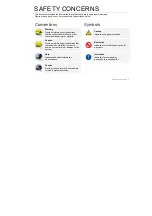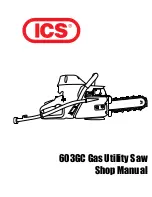
24
| English
– Slide the lock-off switch
(2)
forwards and press the saw
into the base plate
(8)
until this locks into the position for
changing the saw blade.
– Clean the saw blade
(25)
and all the clamping elements
to be fitted.
– Place the saw blade
(25)
on the mounting flange
(26)
.
The cutting direction of the teeth (direction of the arrow
on the saw blade) must match the rotational direction of
the arrow on the protective guard
(15)
.
– Attach the clamping flange
(24)
and screw in the clamp-
ing bolt
(23)
in rotational direction
➌
. Ensure that the
mounting flange
(26)
and clamping flange
(24)
are in-
stalled in the correct position.
– Press and hold the spindle lock button
(28)
.
– Use the hex key
(9)
to tighten the clamping bolt
(23)
in
rotational direction
➌
. The tightening torque should be
6–9 Nm, which corresponds to hand-tight plus ¼ turn.
– Flip the lever
(3)
back. In doing so, the saw will automat-
ically spring back to its home position.
Dust/chip extraction
The dust from materials such as lead paint, some types of
wood, minerals and metal can be harmful to human health.
Touching or breathing in this dust can trigger allergic reac-
tions and/or cause respiratory illnesses in the user or in
people in the near vicinity.
Certain dusts, such as oak or beech dust, are classified as
carcinogenic, especially in conjunction with wood treatment
additives (chromate, wood preservative). Materials contain-
ing asbestos may only be machined by specialists.
– Use a dust extraction system that is suitable for the ma-
terial wherever possible.
– Provide good ventilation at the workplace.
– It is advisable to wear a P2 filter class breathing mask.
The regulations on the material being machined that apply in
the country of use must be observed.
u
Avoid dust accumulation at the workplace.
Dust can
easily ignite.
Chip ejector (see figure I)
The chip ejector
(18)
can turn freely.
An extraction hose with a diameter of 35 mm or a dust/chip
bag
(51)
can be connected to the chip ejector
(18)
.
To ensure optimum extraction, the chip ejector
(18)
must be
cleaned regularly.
External dust extraction
Connect an extraction hose with a diameter of 35 mm
(34)
(accessory) to the chip ejector
(18)
. Connect the extraction
hose
(34)
to a dust extractor (accessory). You will find an
overview of how to connect various dust extractors at the
end of these operating instructions.
The dust extractor must be suitable for the material being
worked.
When extracting dry dust or dust that is especially detri-
mental to health or carcinogenic, use a special dust ex-
tractor.
Operation
u
Remove the battery from the power tool before carry-
ing out work on the power tool (e.g. maintenance,
changing tool, etc.). The battery should also be re-
moved for transport and storage.
There is risk of injury
from unintentionally pressing the on/off switch.
Operating modes
Setting the cutting depth (see figure C)
u
Adapt the cutting depth to the thickness of the work-
piece
. A space of less than the height of one full tooth
should be visible under the workpiece.
Push the slider
(36)
to set the required cutting depth (ma-
terial thi tooth height of the saw blade) on the cut-
ting depth scale
(10)
.
The cutting depth indicator
(7)
shows the cutting depth
when using a Bosch guide rail. When sawing without a guide
rail, the cutting depth value increases by the thickness of a
Bosch guide rail.
Adjusting the mitre/bevel angle
Place the power tool on a level surface, so that the base
plate
(8)
is fully supported.
Loosen the wing bolts
(13)
and
(16)
. Swivel the saw to the
side. Set the required mitre/bevel angle on the scale
(11)
.
Retighten the wing bolts
(13)
and
(16)
.
Note:
Do not exert
any force on the auxiliary handle
(4)
or the saw itself. If this
is not adhered to, different mitre/bevel angles can be set un-
intentionally with the wing bolts
(13)
and
(16)
. This means
that the base plate
(8)
will no longer lay flat on the surface of
the FSN guide rail.
If you tighten both wing bolts at the same time, it may be ne-
cessary to support the saw from the bottom of the auxiliary
handle
(4)
. When doing this, do not exert any force on the
auxiliary handle
(4)
or the saw itself to prevent different set-
tings from being implemented.
If the settings have nonetheless turned out to be different,
loosen both wing bolts
(13)
and
(16)
again. Then set the
mitre/bevel angle again as described previously.
The saw can be set to a mitre/bevel angle of -1° or +47°. To
do this, when swivelling, also press the button
(14)
for a
mitre/bevel angle of -1° or a mitre/bevel angle of +47°.
Note:
When making mitre cuts, the cutting depth is less than
the value shown on the cutting depth scale
(10)
.
Note:
The maximum mitre/bevel angle and the maximum
cutting depth are optimised for the use of a Bosch guide rail.
Note:
Using the screws for fine adjustment
(48)
and
(49)
,
you can reset the angle for the mitre/bevel cut, e.g. after an
impact.
Cutting without a guide rail:
For 45° cuts without a guide
rail, the cutting depth should be no more than
(10)
40 mm
to ensure the angle accuracy and the cutting quality.
Cut marks (see figure B)
The 0° cut mark
(33)
indicates the position of the saw blade
when making a 0° cut – when used with or without a guide
rail.
1 609 92A 4XT | (11.02.2020)
Bosch Power Tools
















































